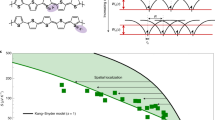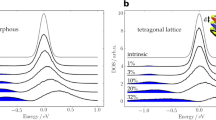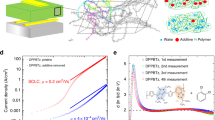Abstract
Doping is one of the most important methods to control charge carrier concentration in semiconductors. Ideally, the introduction of dopants should not perturb the ordered microstructure of the semiconducting host. In some systems, such as modulation-doped inorganic semiconductors or molecular charge transfer crystals, this can be achieved by spatially separating the dopants from the charge transport pathways. However, in conducting polymers, dopants tend to be randomly distributed within the conjugated polymer, and as a result the transport properties are strongly affected by the resulting structural and electronic disorder. Here, we show that in the highly ordered lamellar microstructure of a regioregular thiophene-based conjugated polymer, a small-molecule p-type dopant can be incorporated by solid state diffusion into the layers of solubilizing side chains without disrupting the conjugated layers. In contrast to more disordered systems, this allows us to observe coherent, free-electron-like charge transport properties, including a nearly ideal Hall effect in a wide temperature range, a positive magnetoconductance due to weak localization and the Pauli paramagnetic spin susceptibility.
This is a preview of subscription content, access via your institution
Access options
Subscribe to this journal
Receive 12 print issues and online access
$259.00 per year
only $21.58 per issue
Buy this article
- Purchase on Springer Link
- Instant access to full article PDF
Prices may be subject to local taxes which are calculated during checkout




Similar content being viewed by others
References
Yu, G., Gao, J., Hummelen, J., Wudl, F. & Heeger, A. Polymer photovoltaic cells: enhanced efficiencies via a network of internal donor–acceptor heterojunctions. Science 270, 1789–1791 (1995).
Meijer, E. et al. Solution-processed ambipolar organic field-effect transistors and inverters. Nature Mater. 2, 678–682 (2003).
Alves, H., Molinari, A. S., Xie, H. & Morpurgo, A. F. Metallic conduction at organic charge-transfer interfaces. Nature Mater. 7, 574–580 (2008).
Gutiérrez Lezama, I. et al. Single-crystal organic charge-transfer interfaces probed using Schottky-gated heterostructures. Nature Mater. 11, 788–794 (2012).
Chiang, C. K. et al. Electrical conductivity in doped polyacetylene. Phys. Rev. Lett. 39, 1098–1101 (1977).
Bryce, M. R. Recent progress on conducting organic charge-transfer salts. Chem. Soc. Rev. 20, 355–390 (1991).
Friend, R. Conductive Polymers II: From Science to Applications Vol. 2 (RAPRA review reports, Rapra Technology, 1993).
Inzelt, G. Conducting Polymers 245–293 (Springer, 2012).
Kiebooms, R., Aleshin, A., Hutchison, K. & Wudl, F. Thermal and electromagnetic behavior of doped poly(3,4-ethylenedioxythiophene) films. J. Phys. Chem. B 101, 11037–11039 (1997).
Lee, K. et al. Metallic transport in polyaniline. Nature 441, 65–68 (2006).
Bubnova, O. et al. Semi-metallic polymers. Nature Mater. 13, 190–194 (2014).
Chang, Y., Lee, K., Kiebooms, R., Aleshin, A. & Heeger, A. J. Reflectance of conducting poly(3,4-ethylenedioxythiophene). Synth. Met. 105, 203–206 (1999).
Ikehata, S. et al. Solitons in polyacetylene: magnetic susceptibility. Phys. Rev. Lett. 45, 1123–1126 (1980).
Podzorov, V., Menard, E., Rogers, J. & Gershenson, M. Hall effect in the accumulation layers on the surface of organic semiconductors. Phys. Rev. Lett. 95, 226601 (2005).
Chang, J.-F. et al. Hall-effect measurements probing the degree of charge-carrier delocalization in solution-processed crystalline molecular semiconductors. Phys. Rev. Lett. 107, 066601 (2011).
Uemura, T. et al. Temperature dependence of the Hall effect in pentacene field-effect transistors: possibility of charge decoherence induced by molecular fluctuations. Phys. Rev. B 85, 035313 (2012).
Wang, S., Ha, M., Manno, M., Daniel Frisbie, C. & Leighton, C. Hopping transport and the Hall effect near the insulator-metal transition in electrochemically gated poly(3-hexylthiophene) transistors. Nature Commun. 3, 1210 (2012).
Lee, B. et al. Trap healing and ultralow-noise Hall effect at the surface of organic semiconductors. Nature Mater. 12, 1125–1129 (2013).
Yamashita, Y. et al. Transition between band and Hopping transport in polymer field-effect transistors. Adv. Mater. 26, 8169–8173 (2014).
Senanayak, S. P., Ashar, A. Z., Kanimozhi, C., Patil, S. & Narayan, K. S. Room-temperature bandlike transport and Hall effect in a high-mobility ambipolar polymer. Phys. Rev. B 91, 115302 (2015).
Friedman, L. Hall conductivity of amorphous semiconductors in the random phase model. J. Non-Cryst. Solids 6, 329–341 (1971).
Klein, R. S. Investigation of the Hall effect in impurity-hopping conduction. Phys. Rev. B 31, 2014–2021 (1985).
Seeger, K., Gill, W., Clarke, T. & Street, G. Conductivity and Hall effect measurements in doped polyacetylene. Solid State Commun. 28, 873–878 (1978).
Shacklette, L. W., Chance, R. R., Ivory, D. M., Miller, G. G. & Baughman, R. H. Electrical and optical properties of highly conducting charge-transfer complexes of poly (p-phenylene). Synth. Met. 1, 307–320 (1980).
MacDiarmid, A. G. & Chiang, J. C. Polyanline: protonic acid doping of the emeraldine form to the metallic regime. Synth. Met. 13, 193–205 (1986).
Aziz, E. F. et al. Localized charge transfer in a molecularly doped conducting polymer. Adv. Mater. 19, 3257–3260 (2007).
Zhang, Y., de Boer, B. & Blom, P. W. M. Controllable molecular doping and charge transport in solution-processed polymer semiconducting layers. Adv. Funct. Mater. 19, 1901–1905 (2009).
Cochran, J. E. et al. Molecular interactions and ordering in electrically doped polymers: blends of PBTTT and F4TCNQ. Macromolecules 47, 6836–6846 (2014).
Heeger, A. J., Kivelson, S., Schrieffer, J. R. & Su, W. P. Solitons in conducting polymers. Rev. Mod. Phys. 60, 781–850 (1988).
Kline, R. J. et al. Critical role of side-chain attachment density on the order and device performance of polythiophenes. Macromolecules 40, 7960–7965 (2007).
Tanaka, H., Hirate, M., Watanabe, S. & Kuroda, S.-I. Microscopic signature of metallic state in semicrystalline conjugated polymers doped with fluoroalkylsilane molecules. Adv. Mater. 26, 2376–2383 (2014).
Dingle, R., Störmer, H. L., Gossard, A. C. & Wiegmann, W. Electron mobilities in modulation-doped semiconductor heterojunction superlattices. Appl. Phys. Lett. 33, 665–667 (1978).
Mizoguchi, K. et al. Pauli and curie susceptibilities of polythiophene. Synth. Met. 18, 195–198 (1987).
Efros, A. L. & Shklovskii, B. I. Coulomb gap and low temperature conductivity of disordered systems. J. Phys. C: Solid State Phys. 8, 49–51 (1975).
Orton, J. & Powell, M. The Hall effect in polycrystalline and powdered semiconductors. Rep. Progress Phys. 43, 1263–1307 (1980).
Holstein, T. Hall effect in impurity conduction. Phys. Rev. 124, 1329–1347 (1961).
Le Comber, P. G., Jones, D. I. & Spear, W. E. Hall effect and impurity conduction in substitutionally doped amorphous silicon. Philos. Mag. 35, 1173–1187 (1977).
Gilani, T. H., Masui, T., Logvenov, G. Yu. & Ishiguro, T. Low-temperature Hall effect and thermoelectric power in metallic PF6-doped polypyrrole. Synth. Met. 78, 327–331 (1996).
Long, V. C., Washburn, S., Chen, X. L. & Jenekhe, S. A. Hall-effect study of an ion-bombarded polymer. J. Appl. Phys. 80, 4202–4204 (1996).
McCulloch, I. et al. Liquid-crystalline semiconducting polymers with high charge-carrier mobility. Nature Mater. 5, 328–333 (2006).
Mityashin, A. et al. Unraveling the mechanism of molecular doping in organic semiconductors. Adv. Mater. 24, 1535–1539 (2012).
Lee, P. A. & Ramakrishnan, T. Disordered electronic systems. Rev. Mod. Phys. 57, 287–337 (1985).
Ahlskog, M., Reghu, M., Heeger, A., Noguchi, T. & Ohnishi, T. Electronic transport in the metallic state of oriented poly(p-phenylenevinylene). Phys. Rev. B 53, 15529–15537 (1996).
Väkiparta, K. et al. Anisotropy of magnetoconductivity in oriented poly(acetylene) doped with iodine. Synth. Met. 57, 4860–4865 (1993).
Aleshin, A. N., Kozub, V. I., Suh, D. S. & Park, Y. W. Saturation of dephasing and magnetoresistance features in heavily doped polyacetylene. Synth. Met. 135–136, 303–304 (2003).
Mukherjee, A. K. & Menon, R. Magnetotransport in doped polyaniline. J. Phys. Condens. Matter 17, 1947–1960 (2005).
Zanettini, S. et al. Magnetoconductance anisotropy of a polymer thin film at the onset of metallicity. Appl. Phys. Lett. 106, 063303 (2015).
Hikami, S., Larkin, A. & Nagaoka, Y. Spin–orbit interaction and magnetoresistance in the two-dimensional random system. Prog. Theor. Phys. 63, 707–710 (1980).
Acknowledgements
The research leading to these results has received funding from an ERC Synergy Grant SC2 (No. 610115) supported by the European Research Council. K.K. thanks the Samsung Scholarship Foundation for financial support. S.W. thanks H. Matsui and J. Takeya of University of Tokyo for stimulating discussions, and is supported by Research Fellowships of Japan Society for the Promotion of Science for Young Scientists, and JST PRESTO. K.B. acknowledges funding by the German Research Foundation (BR 4869/1-1). S.-i.K. and H.T. acknowledge funding from the Japan Society for the Promotion of Science (No. 25287073). The authors thank D. Venkateshvaran and A. Sadhanala of the University of Cambridge for help with the measurements. Part of this work is based on research conducted at the Cornell High Energy Synchrotron Source (CHESS). CHESS is supported by the NSF & NIH/NIGMS via NSF award DMR-1332208. We thank D.-M. Smilgies, X. Sheng and J. Dolan for their help during the D1 experiment at CHESS. We thank A. Hexemer, R. Pandolfi and C. Zhu for supporting the data evaluation, who are supported by the US Department of Energy under Contract No. DE-AC02-05CH1123, the ECA award Program and the LBNL LDRD “TReXS”. The authors thank Professor Klaus Müllen of Max Planck Institute for Polymer Research for providing CDT-BTZ.
Author information
Authors and Affiliations
Contributions
K.K. and S.W. conceived, designed, performed the experiments, fabricated all the samples, analysed the data and wrote the manuscript with significant input from H.S. All X-ray measurements were done by K.B. and A.S. A.B. performed XPS measurements. I.N. measured the temperature-dependent UV–Vis optical absorption spectrum of PBTTT/F4-TCNQ and M.N. performed FTIR measurements (Supplementary information). ESR measurements were performed by H.T. and S.-i.K. (for PBTTT/F4-TCNQ), and by D.M. and K.M. (for PEDOT/PSS). Z.F. and M.H. synthesized and purified the PBTTT. S.W. and H.S. supervised this work. All authors discussed the results and reviewed the manuscript.
Corresponding author
Ethics declarations
Competing interests
The authors declare no competing financial interests.
Supplementary information
Supplementary Information
Supplementary Information (PDF 5460 kb)
Rights and permissions
About this article
Cite this article
Kang, K., Watanabe, S., Broch, K. et al. 2D coherent charge transport in highly ordered conducting polymers doped by solid state diffusion. Nature Mater 15, 896–902 (2016). https://doi.org/10.1038/nmat4634
Received:
Accepted:
Published:
Issue Date:
DOI: https://doi.org/10.1038/nmat4634
This article is cited by
-
Unraveling the crucial role of trace oxygen in organic semiconductors
Nature Communications (2024)
-
Electrons lighter than ever
Nature Materials (2023)
-
Crystalline structure, molecular motion and photocarrier formation in thin films of monodisperse poly(3-hexylthiophene) with various molecular weights
Polymer Journal (2023)
-
Doping of molecular semiconductors through proton-coupled electron transfer
Nature (2023)
-
Hall effect in gated single-wall carbon nanotube films
Scientific Reports (2022)



